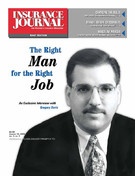Last month the National Association of Independent Insurers issued a bulletin, which described New Jersey’s auto insurance market as “once the nation’s poster child for the dangers of over regulation.”
Donald S. Cleasby, the NAII’s assistant vice president and assistant general counsel, however, also wrote some encouraging words, indicating that “after 30 years of mismanagement, the turnaround so far has been remarkable. And with new insurers coming into the state, the growing consumer choices in automobile insurance which the new law promised won’t be long in coming.”
While he may have a stake in seeing that New Jersey’s reforms succeed—last June he wrote that “the success of this law proves conclusively that if reform can happen in New Jersey, it can happen anywhere.” His observations seem to be supported by facts on the ground.
The N.J. Department of Banking and Insurance, headed by Commissioner Holly C. Bakke, has been moving swiftly to implement the changes mandated when Gov. James E. McGreevey signed The New Jersey Auto Insurance Competition and Choice Act.
Unlike previous reform efforts the new law actually aimed at rolling back three decades of accumulated regulations, which, like weeds choking a garden, were making auto liability insurance less accessible and more expensive in the Garden State—the exact opposite of what they were intended to do.
The state really had little choice. With the highest rates in the country, and advertisements for auto insurance that routinely excluded New Jersey residents from eligibility, the situation had become critical. “We were at a point where several series of reforms—all aimed at bringing down premiums—simply hadn’t worked,” said David J. Madara, executive vice president of the Bollinger Agency and immediate past president of the Professional Insurance Agents of New Jersey (PIANJ). He described the past efforts as being “ill-focused and inadequately implemented,” particularly the AICRA (Automobile Insurance Cost Reduction Act) of 1998. What started out as an attempt to address fraud, medical costs, and the state’s high premiums ended up mandating a 15 percent rollback on automobile insurance premiums, and imposing a complicated set of criteria for determining rates.
The situation has changed. Cleasby pointed to several positive signs that the New Jersey auto market is on the road to recovery.
Mercury Insurance entered the New Jersey market—the first new auto insurer to do so in seven years. State Farm Indemnity, the state’s largest auto insurer, initiated a voluntary rate reduction of 4.1 percent statewide. State Farm also suspended its practice of dropping coverage for 4,000 drivers every month. Allstate Insurance, the state’s second-largest auto carrier, plans to add 15 to 20 new agents, serving an estimated 20,000 more drivers. American International Group (AIG) subsidiaries, the state’s seventh-largest auto insurer, agreed to cancel or postpone by up to four years its plan to end coverage for policyholders and withdraw from the market. USAA, the state’s eighth-largest auto insurer, agreed to reduce rates by 5 percent.
The NAII called these moves “positive indications” of “a radical departure from New Jersey’s troubled past.” It noted, “The state has seen more than 20 insurers pull out of the market over the past 10 years, citing excessive regulation, including long lag times in rate setting, an ‘excess profit’ charge, the inability to adjust prices, and a territorial rating system designed to subsidize urban drivers that has been called ‘socialistic.’ Currently, only about 50 insurers write auto business in the state, compared with many states with 200 or more insurers.”
That’s not an exaggeration. Despite being one of the most densely populated states in the U.S. with one of the highest per capita income levels in the country, none of the major auto insurers—GEICO, Progressive, National, etc.—do business there except State Farm and Allstate. While the over regulation problem has been highly visible, it’s also a symptom of a deeper attitude problem. The industry, rightly or wrongly, has viewed New Jersey as a hostile environment.
That may be changing too. The NAII noted that “since Gov. James McGreevey signed the reform bill into law this June, New Jersey newspaper articles and editorial columns have been highly supportive of the initiative and optimistic about the market’s eventual turnaround.”
Local agent and broker associations, particularly the PIANJ and the Independent Insurance Agents of New Jersey (IIANJ), have been contributing their efforts to making the reforms work. Both organizations have been working with the commissioner on two proposals—Private Passenger Auto Ins.; Use of Alternate Underwriting Rules-PRN 2003-418 (the phase out of N.J.’s “take all comers” law) and Ins. Scenarios-PRN 2003-419 (rules for presenting three alternative coverage options).
The PIANJ said that while it generally agreed with rules that “would require insurers and producers to provide each new applicant for automobile insurance—and any policyholder upon request—with three insurance scenarios demonstrating the effect of different coverage choices,” it had several recommendations to assist consumers in making an informed choice. It suggested that requiring producers to provide quotes for all the companies they represent would probably confuse, more than help, the client to make a choice.
IIANJ Government Affairs representative, Jeanne Heisler, stated: “While the three scenario document is intended to show consumers the scope of coverage provided under New Jersey law, IIANJ cautions that too much generalized information may confuse consumers if the options do not meet their needs.”
In reference to phasing out the “all-comers” law, IIANJ Chairman Scott Stanford, indicated that it “was necessary a decade ago; however, it is now time to move toward a competitive marketplace environment. IIANJ believes that the five year phase out, monitored closely, should provide New Jersey consumers with more options for the purchase of insurance in the future.” That’s the ultimate goal.
The DOBI has also been doing its part in implementing the reform law. In another bulletin from the NAII Cleasby noted that “It’s important not only that the legislation was enacted, but that the department establish the regulations needed to carry out the new law.” On Dec. 15 a number of new regulations came into effect, which did just that, bringing a comment from Cleasby that the department’s “responsiveness to this aspect is in large part responsible for the gains we’ve already seen.”
The new rules were:
A regulation allowing insurers to cancel a policy for anyone who knowingly provides false information on an auto insurance application, renewal or claim.
A regulation concerning information required by insurers for renewal notices, changes to the advance notice for non-renewal notices, underwriting rule requirements for renewal premium and late fees for renewal premium received after the due date.
A regulation establishing general requirements, eligibility requirements, coverage and election standards for the “dollar-a-day” special automobile insurance policies for Medicare recipients to bring them in compliance with New Jersey’s mandatory insurance requirements.
The DOBI also amended existing regulations dealing with rate filing requirements and excess profits calculation, replacing the current standard with a formula based on return on equity, capped at a maximum of 12 percent. It also amended an existing regulation on rate filings reflecting changes in the new law to the “expedited rate filing process” for increases of under a specified percent.
As Cleasby pointed out last June, “For those of us who support state regulation of insurance in the U.S., but insist that it must be improved, we can now use New Jersey as a model of a state that has done just this.” At the time he added a caveat, that the success of the law depended on how well it was eventually implemented. Judging from recent events, it’s being implemented very well, and, although N.J.’s long suffering drivers still pay the nation’s highest auto rates, at last there’s cause for hope. The availability of more insurance options will increase competition, while efforts to fight fraud will bring down costs. Eventually the combination should reduce rates.
Topics Carriers Auto Agencies Legislation New Jersey
Was this article valuable?
Here are more articles you may enjoy.


 Wall Street’s Top Regulator Faces Worsening Battle in Wake of Supreme Court Ruling
Wall Street’s Top Regulator Faces Worsening Battle in Wake of Supreme Court Ruling  The 10 Major Risks Shaping Insurance Today
The 10 Major Risks Shaping Insurance Today  US Home Insurance Still Priced Too Low for Climate Risk, Says Swiss Re Chair
US Home Insurance Still Priced Too Low for Climate Risk, Says Swiss Re Chair  Florida Governor Names Insurance Defense Lawyer to Appeals Court
Florida Governor Names Insurance Defense Lawyer to Appeals Court 


